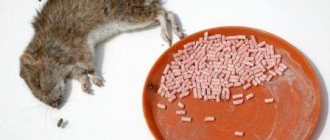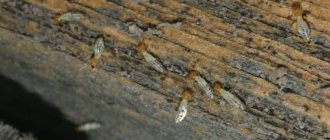Author: Michael Potter Updated: September 20, 2021
There should be no rats in the places where we live and work. Rodents spoil food, clothing, cause damage to property in the apartment and carry more than 70 different diseases, some of which are dangerous to humans. There are many ways to catch and kill pests, and if you don't want to use poisons, you can make your own rat traps. However, simply making a rat trap is not enough, because rodents are very smart animals and require a special approach to catching them.
We will give you some effective tips on how to catch a rat at home using a homemade trap:
- For the trap to work, you need to prepare the bait. Cheeses, cottage cheese, bread, sausages, boiled rice and so on are suitable for this. The food should be as fresh as possible and have a tasty smell, otherwise the rodent will not dare to approach the rat trap.
- It is advisable to place a rat trap where there are the most rodents. Ideal if you can place it in a hole. First, determine whether pests live in it or not. To do this, crumple up a piece of paper and place it at the entrance. If in the morning you find that the paper is scattered, it means the mink is inhabited.
- The rat trap should be installed against the movement of pests. They often move along walls in places where light does not reach.
- Rodents are very clean, so they will always walk along a clean path if the opportunity arises.
- The trap must be kept clean at all times. Wash it regularly with a solution of ash lye or regular soda. Be sure to ventilate it after washing. Do not neglect this recommendation, otherwise the rat trap will begin to emit an unpleasant odor and will repel rats.
Why do rats start
The relationship between rodents and humans has never worked out; pests spoil food, gnaw clothes and walls in the house, and most importantly, like many centuries ago, they become carriers of diseases. The conditions for the appearance of rats and mice in the home can be the following factors:
- sufficient food;
- normal room temperature (heated object);
- location of a landfill or trash can nearby;
- lower floors of high-rise buildings - uninvited guests come from basements;
- unsanitary conditions in a certain apartment can become a nursery, a place where tailed animals spread throughout the house;
- the presence in country houses and sheds where domestic animals live - rats find a constant source of food and steal food from pets.
Ingenuity is man's main trump card in destroying parasites that spoil property and spread life-threatening diseases.
It is not always possible to immediately understand that “gray” robbers have settled in a home. Rats are cautious creatures, of course, if their colony increases, then they will be noticeable visually. You need to pay attention to the following aspects:
- specific smell in small rooms;
- fussing under the floor, behind the walls or squeaking;
- rodent droppings in different rooms and under furniture;
- spoiled food;
- holes and gnawed walls, wooden products;
- "sewn" paper.
Making a trap yourself is quite simple, the main thing is to follow the instructions and “don’t reinvent the wheel.”
Important to remember. Rats are carriers of the following diseases: tetanus, leptospirosis, typhus, etc. They are dangerous for both country houses and city apartments. Catching pests is the key to the health of your family!
1.Installing the lid on the mousetrap
The mousetrap is made from two identical bottles with a capacity of 1.5-2 liters. For the first bottle, only part of the conical part is cut off, and for the second bottle, the conical part is completely cut off. The conical part of the second bottle will be the lid of the trap.
We make two symmetrical holes on the edges of the conical part of the first bottle for attaching a fishing line and hanging a bottle overturned by a rodent on this fishing line. We attach the cap to the top of the first bottle and mark the centers of two holes with a diameter of 5-7 mm coinciding with the centers of the exit holes of the suspension lines. We make holes in the lid. With our own hands we pass the fishing line through the holes in the lid and tie it to the first bottle.
First bottle Cap Line tied Line tucked
How to make a rat trap with your own hands
DIY rat traps are by far the most effective way to catch those pesky rodents. The main thing you need to pay attention to is that the trap should be quite durable and of medium size. You need to take into account the fact that tailed animals can even chew through some types of concrete. In addition, an animal “backed into a corner” becomes as aggressive as possible. A small creature is able to withstand a huge (for these individuals) person. This means that the rat trap must be reliable, and the hostile creature must not, under any circumstances, injure a person.
The main advantage of a homemade trap is that you yourself know how it works, how it works, and you can also make a number of changes and modifications yourself.
A homemade device is sometimes more effective against rodents than purchased models. You can put your creative ideas into the mechanism; in addition, rats are curious and are attracted to incomprehensible designs.
In order to make a trap with your own hands, you do not need to create “high-tech” units; clear and simple designs that do not require specific materials are the most effective. And if a novice engineer-master shows a little ingenuity, you can create a formidable “machine for destruction.”
Most often, these are rather simple designs for catching rats, which can be made by spending a minimum of time and materials on manufacturing.
Note. If you hope that when several individuals appear, you should not take radical measures, you are deeply mistaken. One pest is capable of breeding about twenty cubs per month. Therefore, only total destruction is the right way out of the situation.
Tipping
This method is catching “tailed robbers,” which means that the animal will approach the bait and fall into a deep space.
Alternatively, you can make a rat trap with your own hands based on a tilting bar.
- One of the popular options for creating a “tunnel”:
- we make an imitation of a tunnel from a plastic pipe or cardboard;
- we attach the tunnel structure to the edge of the table (tape, glue, etc.), the upper part of the device should hang over the “abyss”, and the bottom should be cut off;
- at the very edge, inside the pipe there should be a “treat”;
- where the table ends, you need to place a deep container of water;
- the rat runs along the passage towards the bait and falls down.
- You can also catch annoying animals using another overturning method: place a falling bridge with bait on the edge of the barrel, and bring a ladder (board) to it.
Thus, the rat, tempted by the treat, will end up in the bucket from whichever direction it enters.
Additional Information. Any container: bucket, barrel, can - must be filled with water, so the rodent will not be able to get out.
From plastic bottles
In order to make a trap from a plastic bottle, you don’t need many different materials - one of the simplest methods used in practice. There are a huge number of types of these devices, but their main principle of operation lies in the functional use of the bottle.
This is probably the simplest and cheapest option for a DIY rat trap, and does not require much ingenuity.
Let's look at the most effective traps:
- “Closing trap” - classic type:
- plastic containers are cut (a stylized door is created);
- the cut part is pierced with a straight pin or a wooden stick - this is the fastening for the harness (rubber spring);
- a similar pin pierces the inside of the container - also a kind of fastening;
- two rods are connected with an elastic band or a tourniquet;
- the release mechanism is attached to the bottom, the bait is hung on it, the pest pulls the bait, the mechanism is triggered, the rat is caught!
- “Spinning trap” - made from an ordinary plastic bottle:
- the container is “fitted” onto a knitting needle or pin (the main thing is that the device rotates freely);
- the finished mechanism is lubricated with sour cream;
- the entire apparatus is attached to a barrel (large bucket);
- a ladder (board) is needed to reach the barrel;
- the animal jumps on the bottle, it turns and the voracious creature flies into the abyss.
An animal sneaking behind the bait will turn the bottle over and fall into the bucket.
Covering live trap
This method of controlling rodents has been known since time immemorial.
- The simplest device is a jar (pan) and a coin. Food is scattered near the trap, the jar is placed on the “money”, the rat will certainly touch the coin when it runs near the trap. The main thing is that at the moment when the stylized trigger is touched, the animal is inside the device.
- More modern option:
- we find a suitable container (bucket, pan, etc.);
- We install a rod inside the container and tie a thread with bait onto it;
- the thread should also be attached to the coin (sometimes a cardboard corner is used, and the bait is placed on it;
- the mammal pulls the thread, the stand falls, the “glutton” is caught!
You can make such a rat trap with just a jar, bait and a coin.
Cage traps
Homemade products of this type have proven themselves very well in pest control. For some people, this design may be a heavy option, requiring iron materials and a drawing of the mechanism. Of course, if you want, you can master this method too - this is not a “high-precision converter project”, but an iron rat trap.
- a sufficiently strong steel cage is required;
- on the one hand, a door is attached to the cage, which is lowered using a spring;
- at the end of the fence food is attached to the trigger mechanism;
- The tailed one grabs the treat, the device works, the doors close!
Not the most common, but one of the most effective options for catching small pests.
Tunnel trap
This design is very often used to exterminate not only rats, but also mice and moles in summer cottages; it is not like a tunnel-type rat trap that tips over; it operates on a completely different principle:
- you need a piece of pipe (plastic) or other product sealed at one end;
- needles are attached to the end and are directed inward;
- the bait is placed inside the trap;
- the individual enters inside unhindered, cannot get out, the needles kill the animal, or it will remain inside the trap.
An interesting type of homemade rat trap.
Cylinder traps work on the same principle, but without needles. The animal climbed inside and couldn’t get out because of the smooth walls.
Silky
To be honest, this method of catching rodents is quite troublesome. The reason is the small size of the animal. But, if you get used to it, you can successfully complete your hunt. Here's everything you need to make such a trap yourself:
- nylon cord;
- a piece of fishing line;
- insulating tape;
- sinker;
- stationery rivets;
- nuts, bread for bait.
An ancient method that was invented a long time ago by hunters who hunted small forest animals.
For this unit to work successfully, you need to clearly select the load in mass equivalent. If it is too light, the tourniquet simply will not tighten with the required jerk. And the object of the hunt will run away.
Let's get started:
- you need to make a loop from the cord;
- the imitation noose must be attached to any wooden surface;
- the bait must be attached to the same surface, the path of the animal must clearly pass through the noose (you must also take into account that the rat must remain in the middle of the loop while capturing the bait);
- we attach a fishing line to the “treat”, stretch one end to the noose;
- We hang a sinker in the center on the fishing line;
- the annoying rodent grabs the bait, the sinker pulls down, the noose tightens.
Place the loop and bait so that when the rat reaches for the food, the loop is in the middle of the pest's body.
Note. This technique is universal and suitable for individuals of different ages.
Zürner trap
This technique is very similar to classic overturning traps, but with its own characteristics.
- visually the trap resembles a wooden toy house;
- there are two entrances;
- a narrow corridor where there is a bait station at the central point of the canopy;
- the floor is hinged on both sides;
- a small creature wants to feast on a delicacy, but instead falls into the “basement” of the house, and the floor boards return to their original position.
The classic trap, the principle of which is used in many similar traps, is not necessarily for rats.
It is unlikely to purchase a unit in a store; all elements must be made independently. Due to the troublesome nature of the project itself, such a trap is rarely used in practice.
Additional Information. This device gives you a chance to catch several rats.
Glue traps
There are many rat traps of this type on sale, but it is not always possible to purchase the device. For example, in the countryside or in small shops these products are often not available. It’s easy to make such a trap yourself. You need to buy specialized glue that attracts animals with its smell. We take a sheet of cardboard and spread it with glue, and put complementary foods in the middle. A floundering creature, attracted by a peculiar aroma, will completely stick to the surface.
In household or hardware stores, you can often see glue with images of rats or mice on the shelves. This is a special glue for catching rodents.
Important! There are significant disadvantages of such devices: the animal, as a rule, does not die immediately, but gets nervous and screams, which is very unpleasant for susceptible individuals. A cat or dog can also get caught in a trap, and then it takes a very long time to get them out of the uncomfortable situation.
Electric rat trap
Models of electrical devices are quite popular today. They are not as difficult to make as they seem:
- you need plywood on which holes are made for the wires;
- We cut out several rectangles from aluminum cans and make holes in them;
- we stretch the wires through the slots (we make different polarities in the wiring);
- you need to output two common wires to the structure (plus and minus);
- we attach rectangles on plywood (with glue), in one row, at a short distance (we connect a phase to one plate, and a zero to the second);
- you will need an electronic unit, which can be borrowed from an insect racket; we place it on plywood, short-circuit the electrodes in order to remove the existing charge;
- add a capacitor;
- cut off the bottom of the plastic bottle, install it in the form of a house on top of the aluminum rectangles;
- food is poured inside the house;
- we plug the trap into the network, the animal receives an electric shock when it touches both plates.
A relatively humane method for those who do not want to look for options on how to kill a caught rodent.
Wire noose
The trap of such a device can exactly replicate the structure of a snare. Just use steel wire instead of a cord. You can also make an imitation of a hunting snare, attach a steel noose to the surface near the bait, so that the animal that reaches for the bait has a deadly noose on its body.
An interesting option for catching parasites, often used when hunting small animals living in burrows.
In order to fix the animal in the hole, a wooden beam is made with several “holes” and spring mechanisms.
Plastic trap pit
To set up such a trap, it is enough to have a container (from five liters), you can use a bottle:
- on the open space, place a Whatman paper cut in the middle using a ribbon method or a regular sheet of paper (with a cross-shaped size);
- the paper is secured with tape;
- bait is suspended above the container;
- a bridge is made from a board to the top;
- the animal jumps on the paper, trying to reach the treat and falls into the “abyss”!
The rodent will reach for food and fall down into the trap.
Tin Can Trap
Very similar to the Spinning Bottle design, only here we use a beer can. The mechanism turns and the rodent is in the bucket!
Versha
To catch rats, they use tops, similar to fishing gear. A cage with a cone entrance: the animal runs inside, but cannot go back out - the second entrance is a dead end. You can't go back either, the door only locks in one direction. The general meaning is that there is an entrance, but no exit!
The rat will climb inside the trap, and the mesh behind it will return to its previous position, preventing the rat from getting back in.
How to catch a rat at home? Today there are plenty of options: you can get a cat, use chemistry, but it’s better to make a rat trap with your own hands!
Option number 3: covering live trap
This is perhaps the simplest version of a homemade rat trap. To catch a rat or mouse with it, just take a pan and a coin of suitable size - turn the pan upside down, tilt it slightly and rest one edge of it against a coin placed on its edge.
Bait is placed under the pan. When the rodent climbs for the bait, it will certainly touch the coin, it will tip over and the pan will cover the animal.
Here is an example of an implementation where a jar is used instead of a pan:
The disadvantage of the design is frequent false alarms (when a rat touches a container or coin before it has climbed inside the rat trap).
A more sophisticated homemade trap of this type is the improved “coin container.” For example, a container can be rested on an unstable stand, a thread can be tied to the stand, the thread can be thrown over a spacer in the container and the bait can be tied to it:
The rat will sneak under the container, pull the bait and move the “guard”.
Another option is to use a strip of cardboard of sufficient height instead of a coin with a special corner for attaching bait:
Here the animal, pulling the bait, knocks over the cardboard and covers itself with the trap.
It is only important to keep in mind that to make homemade rat traps you need to take a container that is heavy enough so that the rat cannot move it.
The video below shows another interesting example of such a rat trap:
How to install correctly
Most successful rat catchers say that traps should be placed in the habitats of the animals. You can not immediately set a trap, but lull the wary animal’s vigilance by placing bait on an unspecified trap. A constant diet will make the rat less cautious and the success of the enterprise is guaranteed.
Traps should be installed in places where pests appear; they can be identified by a large accumulation of excrement.
After use, the trap must be cleared of the smell of the deceased creature, so as not to scare away new “candidates for capture.” The trap must be installed against the movement of the “tail”.
Additional Information. The rodent does not like illuminated areas and moves near walls and not in open areas - this must be taken into account when installing trapping devices.
Option #7: Zürner trap
This classic trap works on the same principle as the tipping rat traps described above. Its difference lies only in the completeness of the design and appearance: the Zürner trap is a wooden house with two entrances, in which the bait is located in the middle of the “corridor”, and the floor on both sides of it is made of boards on hinges. When the animal approaches the bait, the board collapses under its weight, the animal falls into a large closed chamber, after which the board returns to its original position on a hinge.
The figure below shows a diagram of such a rat trap:
Thanks to its successful design, the Zürner trap can catch several rats at once.
As a rule, such a trap is made independently from wood, since the industry has not established the production of Zürner traps. Despite its effectiveness and certain advantages, the Zürner trap is rarely used in practice, largely due to the complexity of manufacturing.
The best bait for a rat trap
The diet of rats is varied; traps can be loaded with the following baits:
- cheese;
- grain crops;
- bakery;
- cottage cheese;
- sausage;
- smoked meats;
- sour cream;
- nuts;
- sunflower oil and seeds;
- salo;
- even beer, etc.
Animals love fresh and smoked food most of all; rodents should not be underestimated, they are quite selective.
Making a mousetrap from a bottle and a jar
There are several options for bottle or jar traps. They are all based on the same principle, but there are differences in design and, accordingly, manufacturing.
Option 1
Materials and tools: plastic bottle, knife, vegetable oil, bait, and, if desired, adhesive.
Manufacturing procedure:
- The bottle is cut into two parts (2/3 lower part with a bottom and 1/3 with a neck). Then the part with the neck is turned over and installed inside the first part with a bottom.
- The neck is moistened with vegetable oil. Any bait should be placed inside. The trap is left in places where rodents accumulate.
The smell of oil and bait attracts mice. Its properties are such that the rodent rolls down the slippery surface of the neck, lubricated with oil, into the part with the bottom. There is no way for him to get out of there.
Option 2
Materials and necessary tools: rope, bottle, knife, bait.
This option is based on gravity. It is made as follows:
- The neck of the bottle is cut off. The remaining part is placed on the edge of a table or other surface so that the part with the bottom hangs slightly over the edge. The bait is placed closer to the bottom. A rope of such length is grabbed to the edges that when the bottle falls, it does not fall to the floor, but hovered before reaching it.
When moving towards the bait inside the bottle, the animal shifts its center of gravity, causing the container to slide off the table and hang in a vertical position on the rope. It is impossible for a rodent to get out in this position.
Mouse trap from a jar
Materials: jar, thick paper, knife.
Manufacturing procedure:
- A sheet of paper is placed on the wide neck of the jar. The part of the sheet located directly above the neck is cut crosswise with a sharp stationery knife or razor blade. The bait can be placed inside the jar, or (if it is very light in weight) on the “petals” that are formed after the cuts. There is also an option to place the bait on a rope directly under the intersection of the cuts. The can is installed in places where it will be easy to access its neck when moving from adjacent surfaces, or original “ramps” are built, the material for which can even be the same paper.
When moving along the petals, the rodent, under the weight of its own weight, falls through the “petals” of paper into the jar, from where it can no longer escape. The disadvantage of the design is its low efficiency: often animals, while moving, feel the danger of falling through and retreat.
Bottle rotating in a bucket
Materials: bucket or basin, bottle, rod or wire made of any metal.
Manufacturing procedure:
- Holes are made in the bottom and neck for a metal rod. The rod is threaded through them so that the container can rotate freely on this axis. The edges of the axis should protrude enough so that it can be placed on the edges of a bucket or basin. It is recommended to fill this vessel with water or leave it empty .The bottle is lubricated with some odorous food. This could be processed cheese or sunflower oil. It should attract rodents. A “ramp” is also created from the floor to the edge of the bucket.
The mice, smelling the pleasant smell of food, climb up the created platform to the edge of the bucket and try to get onto the bottle. Due to the properties of the plastic, as well as due to the circular movement on the axis, the rodents fall into the lower vessel, remaining there until the owners arrive. This option is one of the most effective and witty.
Trap from a jar with a coin
Materials: a jar (although it can be replaced with a saucepan or any similar vessel) and a coin (which can also be successfully replaced with various round objects like old large buttons, washers).
How to make:
- A coin is placed under the jar, placed on the neck, for support so that a gap is created between the glass and the floor. A small thread is attached to the coin. A rod is tied to the other end of the thread. The bait is attached to the rod.
When the mouse touches the bait, it pulls the rod, which is connected to the support by means of a thread. The support falls, and with it the trap-jar slams shut. The only disadvantage of this design is its disposability - after each caught mouse it needs to be “recharged”.
The best commercial rat traps
The following commercial traps can be distinguished:
- Press traps.
- Tunnel traps.
- Electrical devices.
- Mesh traps.
- Ultrasonic repellers, etc.
For many, ultrasonic repellers have already become an excellent alternative to other control methods that involve killing animals.
Beautiful fake “Little Mice” crocheted with diagrams and descriptions in amigurumi style
The symbol of the coming year can also be crocheted from beautiful soft yarn. You can use such crafts as Christmas tree decorations, or you can decorate your New Year’s table with them. Offering a detailed description of how to knit a mouse, even a beginning knitter can handle it.
You will need:
- Yarn for knitting milky, pink and pink 100% acrylic 400/100m;
- Crochet hook 1.25;
- 2 black beads;
- 1 pink bead;
- Needle and thread;
- Stuffing for toys;
- Thin white line.
Creation stages:
1. The mouse’s head is knitted first. The finished piece must be stuffed with stuffing and finished knitting by decreasing the row to 6 loops.
2. Now the lower legs are knitted using pink thread.
3. After this, the upper legs are knitted.
4. To knit the ears, use a gray thread at the beginning of knitting, and then continue knitting with a pink thread.
5. Now the mouse’s body itself is knitted; do not forget to stuff the parts with filler to give them volume.
6. The last thing to knit is the mouse’s tail. Once all the parts are knitted, they will need to be sewn. Glue on black eyes, a pink nose and insert antennae from fishing line.
Even a knitter without experience can handle such a simple pattern, the main thing is to have the desire.
What to do with a rat trap and a caught rat
Of course, a person is no longer a medieval barbarian, but in relation to a caught rat, there is only one solution - liquidation. This can be done as follows:
- add water to the container so that the animal drowns;
- a precise blow to the head with something like a bat;
- shoot the pest if you have a suitable weapon;
- if it is possible to transfer the animal into a sealed container, you can send the “criminal” to the gas chamber. Mix soda and vinegar in a cup, pour into a container, the animal will suffocate (this is considered a humane method of punishment).
The methods described seem terrible, but a person cannot, like the Pied Piper of Hamelin, control animals with a pipe, so there are simple methods of elimination.
Still, the best way would be to choose a trap that does not cause any injury to the animal and subsequently release it away from the area.
Option number 6: snare
Generally speaking, catching rats with snares is quite problematic due to the small size of the animals. However, if you try, you can still catch the pest, and there is even a small life hack that allows you to make such a rat trap with your own hands from improvised means.
For this you need:
- Cable tie;
- A piece of fishing line;
- Heavy load - for example, a wrench;
- Paper clip;
- Bait - for example, a crust of bread.
This is how a homemade rat trap made from a cable tie works in practice:
On a note
When making this trap, it is important to choose the right weight of the load. If it is too small, it will not tighten the tie with the necessary force, and the rat will run away. If the load is too heavy, then using such a structure as a live trap will not work - the animal’s ribs will be broken by the loop.
Preventing the appearance of rats in the house
For preventive actions to prevent the appearance of rodents in your home, you need to follow the following recommendations:
- seal openings and cracks in the house;
- get a cat;
- throw away garbage on time;
- tidy up the apartment;
- Do not flush food waste down the toilet;
- find a separate place for products and cereals, where there is no access for pests.
Cats are an effective rat repellent.
Rodents really don't like the smell of cats. Homemade products for fighting rats have proven themselves to be excellent. They are effective even in comparison with some factory products. If “uninvited guests” appear in the house, there is a way out - the complete extermination of the entire colony using simple, homemade devices!
Option #4: cage traps
Such designs are characterized by high reliability, durability and efficiency, but they are quite difficult to make yourself. Their manufacture requires special materials and parts: the body itself is made of durable steel mesh, metal or wood panels, and the trigger mechanism is based on a spring. However, with sufficient desire and skill, assembling such a device with your own hands will not take much time.
The principle of operation of the rat trap is as follows:
- The cage has a rising door with a guard - when alert, the trap door opens upward with spring tension;
- At the end of the cage, a bait is attached to a hook, the other end of the hook holds a guard;
- When the rat pulls the bait, the gate lowers and the door slams shut.
The video below shows examples of manufactured rat traps of this type:
Fishing principles
Rats get used to one familiar bait. This means that it should not be kept in a rat trap for more than 3 days in a row.
It is better to replace it with a new bait more often in order to lure it out and not cause alertness or suspicion in the rat. Despite the fact that the animals are omnivores, they still like to give preference to their favorite foods, rushing into the trap
If mechanical traps are used, it is important to place them near the walls and block access to them for children and pets. It is worth keeping rat traps clean at all times.
Handle them only with gloves. Regularly remove food products from the kitchen, leaving no food sources other than a mousetrap. Store cereals in glass or metal jars.
Rat football
While watching their tailed pets fuss, owners often notice how rats chase food pellets or raisins throughout the cage, using them as balls. So why not arrange a football championship for your pets, giving them the opportunity to feel like real football players? This type of entertainment will be especially relevant if there are several rats in a cage. The animals will begin to fiddle with the ball with delight, rolling it around the cage and trying to take it from each other.
You can use the following as a soccer ball for rats:
ping pong balls; walnuts or hazelnuts; balls of foil or paper; small round skeins of thread wrapped with tape.











